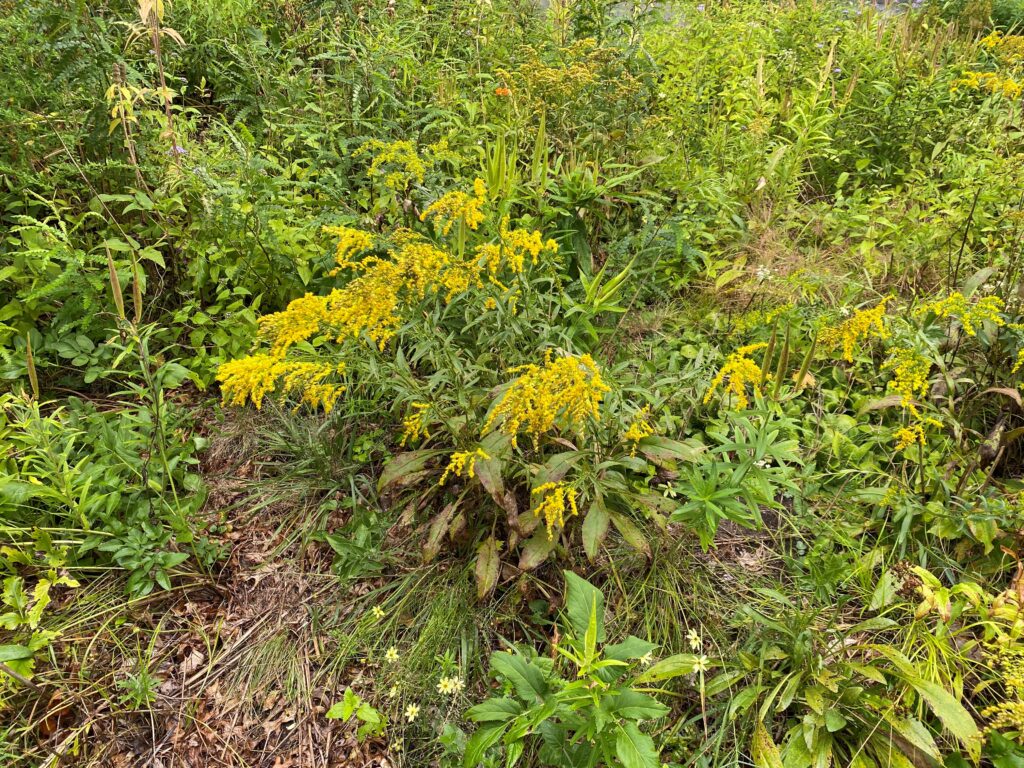Horticulture Highlight: Goldenrods, Solidago spp.
Jim Gorman September 2, 2025 Plants & Wildlife

…Heavy waves of goldenrod in the morning breeze;
Celia Thaxter
Swift spring the startled grasshoppers, thick about our knees…
Goldenrods, Solidago spp. are a very showy part of the late-summer, and into autumn, eastern North American landscape. With more than120 species worldwide, there are 100 species native to the United States and Canada, 8-9 species native to Mexico, and another 10-12 species native to South America, the Azores, Europe and Asia. All are herbaceous perennials, having erect stems which are sometimes rather woody at the base. The leaves are simple, alternate, entire or serrate, often aromatic. The tiny, golden-yellow, flowerheads form wand-shaped clusters on the upper ends of outward curving branches.
…The first yellowing fronds of goldenrod
Jane Kenyon
brighten the margins of the woods…
Carl Linnaeus (1707-1778) used the genus name Solidago in his 1753 landmark publication Species Plantarum, which introduced the accepted usage of binomial nomenclature to greatly simplify the previously long and cumbersome plant names. Solidago is from the Latin Solido, to make whole, from its supposed healing attributes. For centuries these flowers and leaves have been considered to have healing value. Well before Elizabethan times (ca.1560-1600), European species of goldenrod were commonly useful for treating sores and ulcers.

Multiple native American populations were also known to use goldenrod beneficially. The Cherokees prepared a tea to reduce fever. The Delaware used one species as a diarrhea remedy. The Navajos and Meskwaki created a poultice to gain relief from bee and wasp stings and ant and insect bites. The Zuni chewed goldenrod flowers, slowly swallowing the juice to cure sore throats.
…a late summer lit
Jay Wright
only by goldenrod and a misplaced strand
of blackberries…
Visionary founder of Mount Auburn, Jacob Bigelow (1787-1879), physician, botanist and Harvard Medical School Professor for forty years, noted goldenrods’ challenging taxonomy, as well as its medicinal utility. In his 1817, American Medical Botany: Being a Collection of Native Plants of the United States, Bigelow wrote of Solidago odora, Sweet goldenrod, “No part of the vegetation in the United States is so conspicuous and gaudy in the autumnal months, and at the same time furnishes the botanist so difficult a task of discrimination, as the multitudinous and Protean genera Solidago and Aster. Each of these genera contain many well defined species…But between them is a great multitude of subspecies…running together by so many points of resemblance, that it is a labour yet remaining for botanists to separate those species which are in nature distinct, from those which are varieties only.” Regarding its medicinal use, he wrote further, “…the volatile oil appears to possess all the medicinal value of this plant … I have employed it to allay vomiting, and to relieve spasmodic pains in the stomach of the milder kind, with satisfactory success. From its pleasant flavour, it serves to cover them to be rejected by delicate and irritable stomachs.”
…A father called
Rebecca Hazelton
to his daughter to see monarch butterflies,
pausing in their migration to fan the goldenrods, …
Borrowing on au courant lexicon, we also have some wicked local historical trivia regarding goldenrod. The original Tea Party in Boston, on December 16, 1773, in which a reported 45-tons of tea were thrown into Boston Harbor, resulted in among other things, the closure of the harbor to trade pending payment for the destroyed tea. Hence, with no tea around local ingenuity came up with a widely accepted substitute, called Liberty Tea, who’s major ingredient came from the leaves of goldenrod.
…goldenrod blowing. We walk
Donald Hall
into the graveyard, to find
my grandfather’s grave …
Goldenrods are often unfairly maligned for causing autumn hay fever. However, this is nothing to be sneezed at. To cause one to sneeze, a plant’s pollen needs to get into one’s nose. Goldenrods’ pollen is too heavy and sticky to be blown around by breezes. The real culprit is ragweed, Ambrosia sp., which takes advantage of a major case of mistaken identity. Ragweed’s inconspicuous, tiny, green, flowers spew vast amounts of very light allergy-irritating pollen into the air, then hence into noses.
On your next visit to Mount Auburn, look for some of the different species of goldenrod growing here. Blue-stem goldenrod, Solidago caesia and zigzag goldenrod, Solidago flexicaulis grow along Indian Ridge Path. Sweet goldenrod, Soidago odora may be found near Consecration Dell. Stiff goldenrod, Solidago rigida, early goldenrod, Solidago juncea, along with several other cultivars grow as well within our living collection.


Comments
Comments for this post are closed